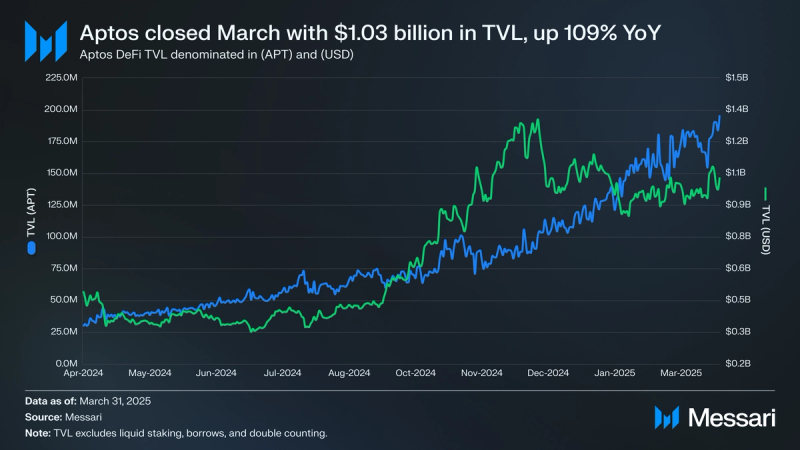Key Insights
- Aptos has positioned itself as “the global trading engine” through a series of strategic initiatives, technological developments, and continued DeFi ecosystem growth.
- After first surpassing $1 billion in total value locked (TVL) in November, Aptos closed March with $1.03 billion in TVL, marking sustained growth from the network’s prior TVL range of $300-500 million from late March to mid-September 2024.
- Numerous DeFi milestones have taken place on Aptos in recent months including Aave’s first non-EVM deployment of its testnet in January and liquid staking protocol Amnis Finance’s airdrop of its AMI token in March.
- On March 24, the total stablecoin market cap on Aptos surpassed $1 billion for the first time, a more than 10x increase year-over-year. In October and January, native contracts for Tether’s USDT and Circle’s USDC, the two largest stablecoins, were deployed, while a bridged token contract for Ethena’s USDe, the third largest stablecoin, was deployed in February.
- Key technologies introduced to scale Aptos and thereby facilitate global transactions include Zaptos, which reduces end-to-end transaction latency, and Shardines, which applies sharding to Aptos’s execution engine.
Primer
Aptos (APT) is a Layer-1 blockchain designed around the core tenets of scalability, safety, reliability, and upgradeability. Aptos was born out of Meta’s Diem and Novi projects, eventually launching in October 2022. Core developer Aptos Labs raised about $400 million in two 2022 private investor rounds.
Aptos’ technological stack features many novel aspects, including the AptosBFTv4 consensus mechanism, the Quorum Store mempool protocol, the Block-STM parallel execution engine, and the programming language Move. Aptos Move, which builds on the original Move language created by the Diem and Novi teams, offers enhanced flexibility and safety compared to other Web3 programming languages. Aptos Move is being co-developed by multiple protocols.
Other key features aim to improve user experience and safeguards, including accounts where private keys are decoupled from public keys, transaction pre-execution to explain the outcome of a transaction before a user signs it, and transaction expiration time and sequence numbers. Development of the Aptos network and growth of the Aptos ecosystem is primarily led by Aptos Labs and the Aptos Foundation.
After first surpassing $1 billion in total value locked (TVL) in November, Aptos closed March with $1.05 billion in TVL, marking sustained growth from the network’s prior TVL range of $300-500 million from late March to mid-September 2024. Amidst this runup, Aptos has positioned itself as “the global trading engine” through DeFi ecosystem growth, as well as a series of strategic initiatives, and technological developments that are the subject of this report. For a full primer on Aptos, refer to our Initiation of Coverage report.
Website / X (Twitter) / Discord
DeFi Momentum and Milestones
After first surpassing $1 billion in total value locked (TVL) in November, Aptos closed March with $1.03 billion in TVL, marking sustained growth from the network’s prior TVL range of $300-500 million from late March to mid-September 2024. Year-over-year, TVL on Aptos has increased 109% in USD terms and 562% in APT terms. This difference emphasizes the absolute growth in TVL in Aptos, even as the APT token price has declined by 47% year-over-year from $9.94 to $5.27.

Top Three Protocols by Total Value Locked (TVL)
Aries Markets, a multi-use DeFi protocol, closed Q1 2025 as the leading protocol by TVL on Aptos with $383.6 million in TVL (+117% YoY), followed by liquid staking protocol Amnis Finance (+26% YoY). In March, Aries Markets partnered with Amnis Finance to award APT in preparation for Amnis Finance’s airdrop of its AMI token, for which claiming began on March 26, 2025. AMI will function as the governance and rewards token of Amnis Finance, with 80 million AMI (8% of the total token supply) allocated to the airdrop. Also in March, Aries surpassed $400 million in stablecoin deposits with more than $210 million in USDT and more than $200 million in USDC. As of March 31, deposit rewards of more than 8% are available for both tokens with base deposit rewards paid in the underlying token and additional yield paid in APT.
Launched in August 2024 to bring Bitcoin liquidity to Aptos, Echo Protocol closed Q1’25 with $205.9 million in TVL, the third highest on the network. Users can mint aBTC on Aptos by bridging uBTC, which is backed 1:1 by BTC, from the B^2 Network. Echo’s lending application allows users to permissionlessly deposit aBTC, USDT, USDC, and APT to earn interest and borrow those assets against deposits. On March 19, Echo launched a new points program to reward protocol usage and participation in partner campaigns.
Ecosystem Milestones
While Aptos’s top three protocols by TVL have shown meaningful growth, numerous other protocols have had developments in recent months worth highlighting:
- Aave on Testnet: On January 7, Aave’s first non-EVM deployment of its V3 testnet took place on Aptos, marking a significant step for the Aave team beyond the EVM and a milestone for Aptos as the first non-EVM chain. As of March 31, Aave V3 remains in testnet on Aptos undergoing safety and performance checks before mainnet launch.
- PACT Protocol: In February, PACT announced the migration of its onchain credit infrastructure to Aptos, with more than $1 billion being migrated. PACT focuses on emerging markets where traditional banking remains out of reach of 85% of the world’s population and is the first participant in Aptos Foundation’s incubation pilot focused on supporting and scaling high-impact blockchain projects.
- Merkle Trade: Merkle Trade is a permissionless perpetual futures contract trading protocol built on Aptos that offers crypto asset, foreign exchange, and commodity trading. Through its Walletless feature, users can trade without a wallet signing with credentials like Google. Moreover, transactions are sponsored via the Aptos Foundation’s Gas Station program, enabling users to trade without paying network gas fees.
- Echelon: In February, Echelon announced a partnership with Ethena to support the adoption and integration of Ethena’s sUSDe within the Echelon lending markets. As of March 31, more than $90 million sUSDE is supplied on Echelon.
Stablecoin Hat Trick

On March 24, the total stablecoin market cap on Aptos surpassed $1 billion for the first time, a more than 10x increase year-over-year, and a 3x increase since December. This increase has been driven almost entirely by market cap increases in Tether’s USDT and Circle’s USDC following their respective native contract deployments on Oct. 28 and Jan. 31. Specifically, USDT’s market cap has increased more than 8x from $78 million to more than $680 million while USDC’s market cap has increased 131% from $128 million to $295 million.
On top of this, a bridged token contract for Ethena’s USDe, the third largest stablecoin by market cap, launched on Aptos in late February making Aptos home to the top three stablecoins by market cap (USDT, USDC, and USDe). Unlike USDT and USDC which are fiat stablecoins backed by US Dollar and dollar equivalents, USDe is a synthetic dollar stablecoin, backed by crypto assets and corresponding short futures positions. USDe can be staked to receive an equivalent value of sUSDe. sUSDe tokenholders earn yield from USDe’s (1) underlying staked crypto assets and (2) the funding rate of short positions. sUSDe is the reward-bearing version of USDe and increases in value over time as value accrues through the yield USDe’s collateral generates.
As of March 31, more than 93.7 million in sUSDe has been bridged to Aptos via Stargate, while only 258 USDe exist on Aptos, indicating a strong user preference to earn sUSDe’s yield. Key use cases for both USDe and sUSDe on Aptos include depositing and borrowing from lending protocols such as Echelon and providing liquidity to stable and non-stable pairs on DEXs like Thala.
Outside of this stablecoin hat trick, other notable stablecoins on Aptos include:
- BUIDL (launched in November 2024): BlackRock’s USD Institutional Digital Liquidity Fund (BUIDL), 100% backed by U.S. Dollar cash, U.S. Treasury bills, and repurchase agreements, with daily accrued dividends paid directly to investors’ wallets as new tokens each month. On Dec. 25, the market cap of BUIDL increased from roughly $1 million to more than $52 million and sits at $53.2 million as of March 31.
- USDY (launched in July 2024): Ondo’s U.S. Dollar Yield Token (USDY), a tokenized note secured by short-term U.S. Treasuries (~99%) and bank demand deposits (~1%). The token is non-rebasing, as the per-token price increases as yield accrues each day. Since August 2024 the market cap of USDY on Aptos has steadily increased from $15.4 million to $16.1 million as of March 31.
- MOD: Move Dollar (MOD), Thala’s overcollateralized stablecoin that can be minted, and thereby borrowed, by depositing a supported collateral asset in a vault on Thala. Since Sept. 30, 2024, the market cap of MOD has declined from $15.3 million to $3.5 million as of March 31.
Technological Developments
While Aptos has a robust DeFi ecosystem, its continued growth depends on technological development to support more users and transactions. In recent months, Aptos Labs has introduced Zaptos and Shardines, two key innovations to reduce latency and boost throughput on Aptos as it scales towards its vision as the hub of global transactions supporting 1 million transactions per second (TPS).
- Zaptos: Aptos employs a pipelined architecture that allows different stages of different blocks to execute in parallel, maximizing resource utilization and thereby improving blockchain performance. Zaptos significantly reduces the end-to-end latency of Aptos’s pipelined architecture through three key optimizations:
- Optimistic Execution: A given validator adds the block to the pipeline immediately rather than waiting for an order to do so.
- Optimistic Execution: Blocks are optimistically committed to storage as soon as execution is completed.
- Piggybacking state certification on Consensus: Validators can start the certification stage of an executive block before waiting for the block to be ordered (in parallel with the last round of consensus).
In a testing environment Aptos Labs found Zaptos reduces latency by 40% under a load of 20,000 transactions per second.
- Shardines: Shardines introduces a horizontally scaled execution engine that divides transactions into smaller partitions, which are processed in parallel across multiple nodes. This allows the network to handle more transactions simultaneously, boosting transaction processing speed. In testing, this approach enabled Aptos to achieve 1 million TPS with 30 shards. Central to this implementation is a hypergraph partitioning algorithm designed to minimize cross-shard network communication and wait times, along with a ‘micro-batching and pipelining‘ strategy that splits transactions within a block into smaller batches, which are then pipelined through various execution stages in Aptos’s parallel execution environment.
While Zaptos and Shardines are two of Aptos’s largest recent technological developments to scale the network, others are also in the development pipeline. In September, Aptos Labs introduced Raptr, its next-generation BFT consensus protocol that implements Directed Acyclic Graph [DAG] techniques to maintain sub-second latency and high throughput. Currently, Raptr is in a testing phase before it can be fully deployed as a replacement for the AptosBFTv4 consensus mechanism.
While major scaling initiatives continue to push the network forward, developer experience and programmability are evolving just as rapidly. In March, Aptos Labs introduced a series of Move developer features for DeFi application development. Key among them are a Dynamic Script Composer to build Aptos transactions in TypeScript rather than directly writing Move scripts, and Account Abstraction, which allows an account to authenticate through custom Move functions rather than native Rust-based authenticators. Ordered Maps and Big Ordered Maps, two new key-value collections, were also added to the Aptos Framework. Both data structures bring increased performance from prior iterations alongside newly introduced Move-native functions.
Conclusion
Through a series of strategic initiatives, technological developments, and continued DeFi ecosystem growth, Aptos has positioned itself as “the global trading engine.” After first surpassing $1 billion in total value locked (TVL) in November, Aptos closed March with $1.03 billion in TVL, marking sustained growth from the network’s prior TVL range of $300-500 million from late March to mid-September 2024. Moreover, on March 24, the total stablecoin market cap on Aptos surpassed $1 billion for the first time, a more than 10x increase year-over-year.
Additionally, numerous DeFi milestones have taken place on Aptos in recent months including Aave’s first non-EVM deployment of its testnet in January and liquid staking protocol Amnis Finance’s airdrop of its AMI token in March. Amidst increasing DeFi activity and user metrics, Aptos’s development team continues to work on scaling initiatives like Zaptos and Shardines to ensure the network remains fast and performant as it scales towards its vision as the hub of global transactions supporting 1 million transactions-per-second (TPS).




















